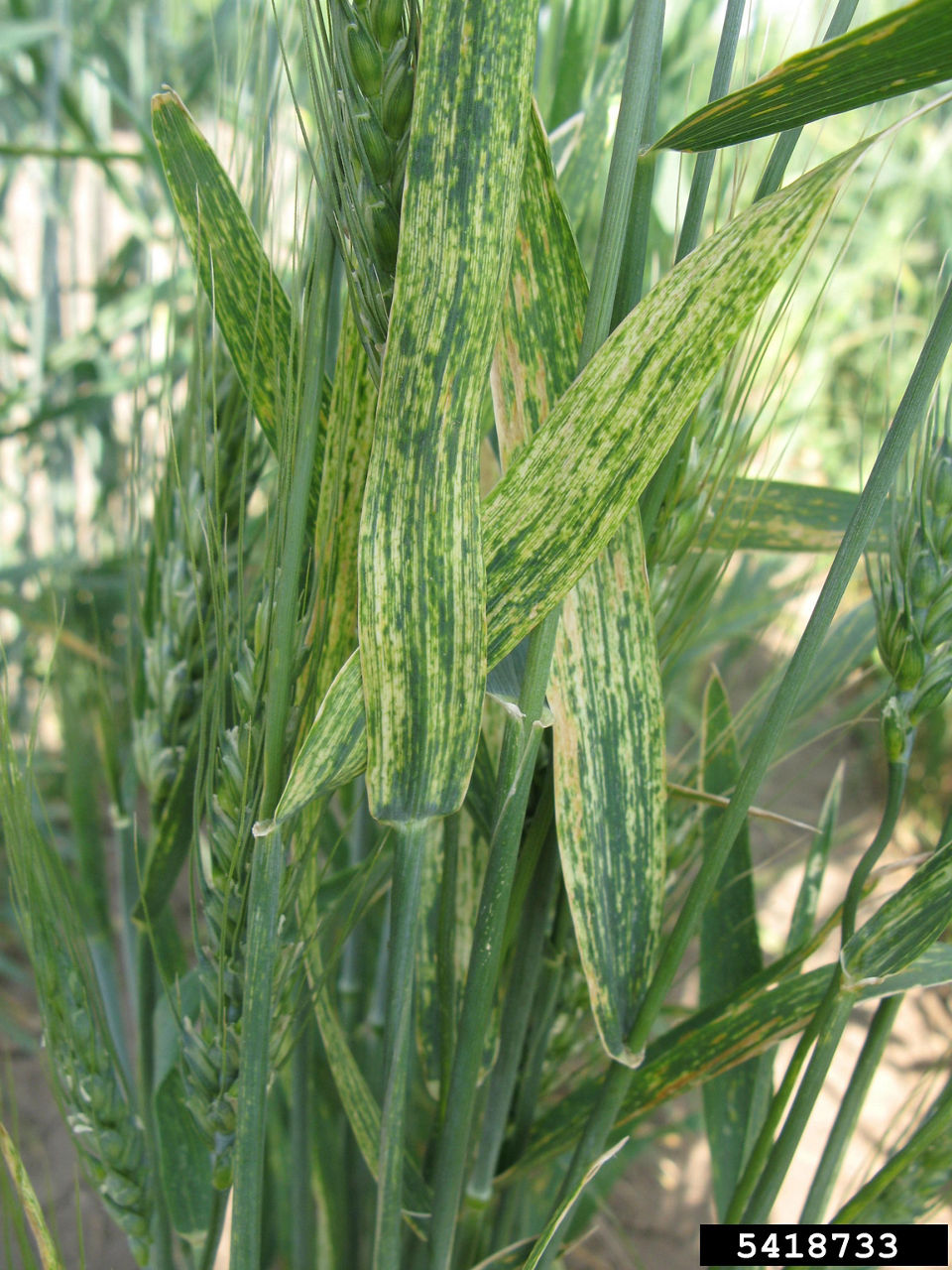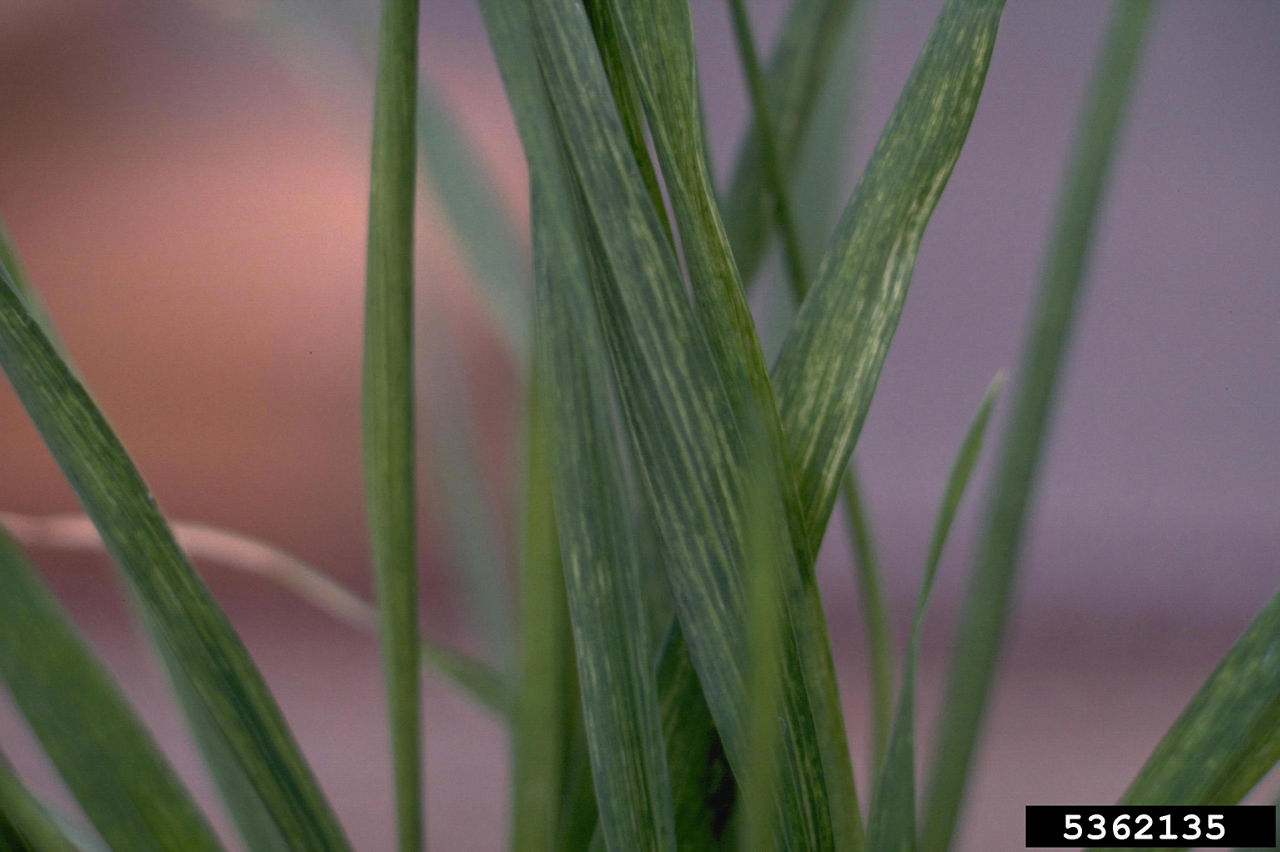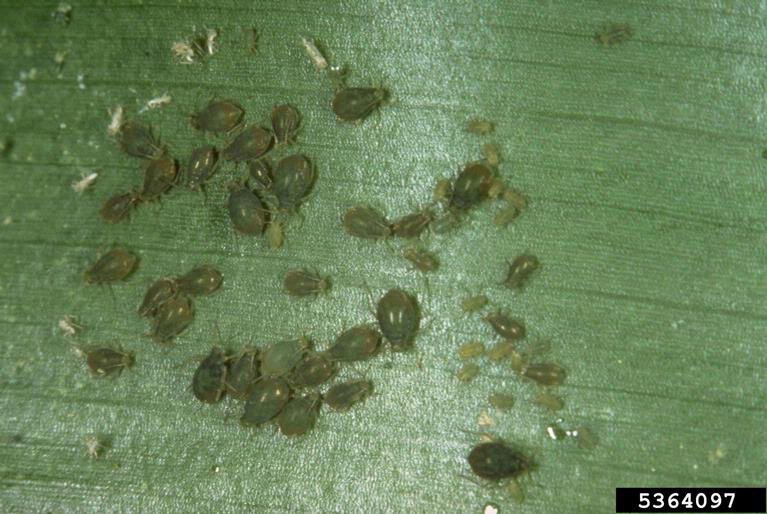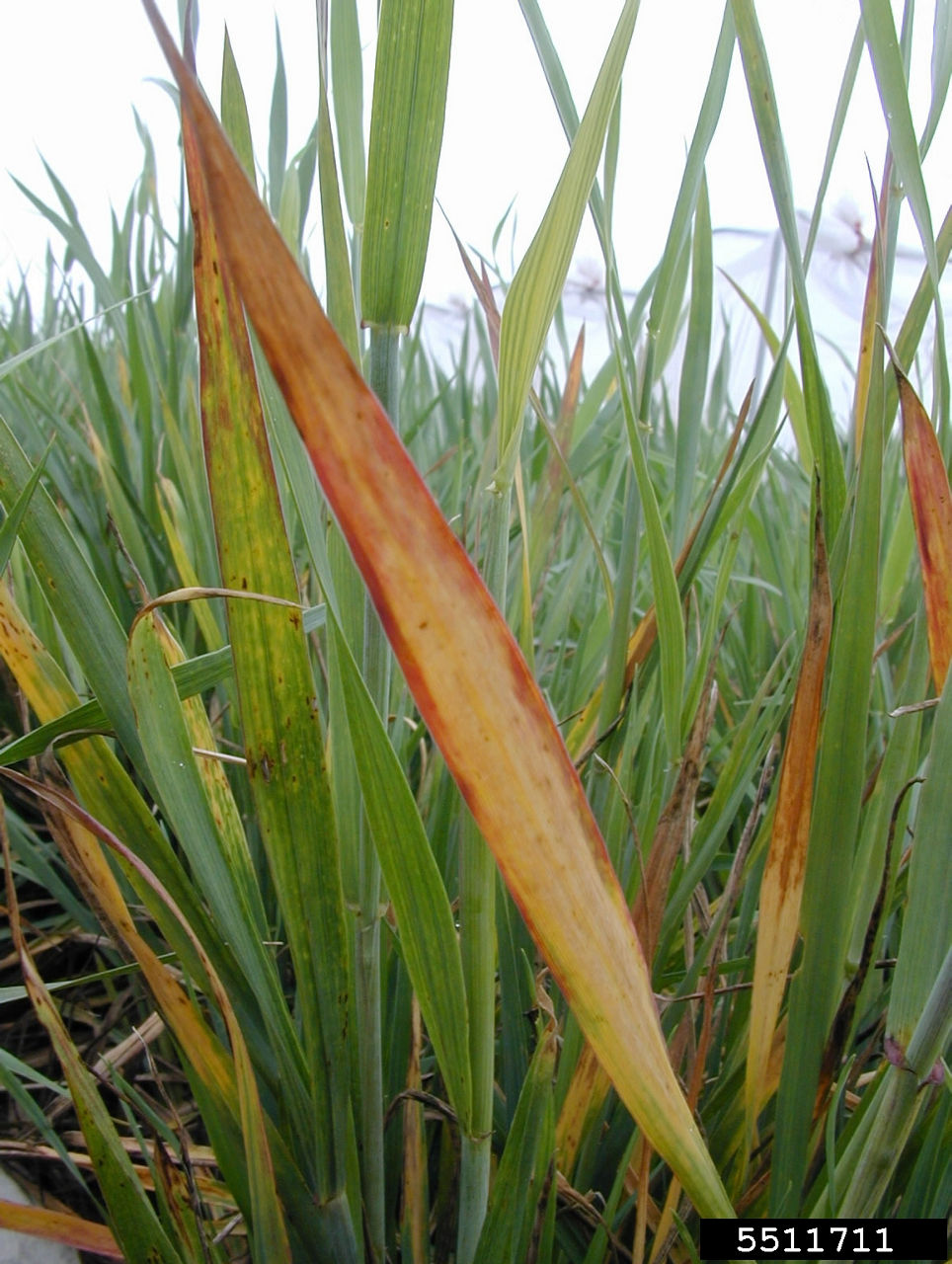Viral Diseases of Wheat
March 5, 2025
- Mosaic coloring, streaking, chlorosis, and stunting are common symptoms presented during viral plant infections.
- Identification may require a laboratory diagnosis; however, identification is necessary for effective disease management.
- The viruses that cause wheat streak mosaic virus, soilborne wheat mosaic virus, wheat streak spindle mosaic virus, and barley dwarf yellow virus infections are vectored or transmitted by organisms in the environment.
- Eliminating vectors is difficult, if not impossible, so host plant resistance is often the most efficient management option.
Wheat Streak Mosaic Virus (WSMV)
Wheat streak mosaic virus is vectored to winter and spring wheat by the wheat curl mite (Aceria tosichella). Wheat curl mite survive on volunteer wheat between wheat crops, allowing WSMV to replicate as well. Wet summers support volunteer wheat growth and the ‘green bridge’ necessary for the survival of wheat curl mites. When the mites land on a wheat plant they move to the youngest unfurling leaf and begin feeding. Wheat curl mites transfer the disease by feeding first on infected plants and then on healthy plants, and can transfer the disease for approximately one week after feeding on infected plants.1 The virus is favored by warm temperatures (greater than 70 to 80 °F) and dry weather.1,2 Plants become stressed, virus replication increases, and the wheat curl mite life cycle occurs at a faster rate in these conditions.3
Symptoms
Plants infected with WSMV are stunted and tiller poorly. Leaves on infected plants turn yellow from the leaf tip to the leaf base, while the leaf veins usually remain green. As the disease becomes severe, leaf mottling turns into brown, dead leaves. Similar symptoms are caused by High Plains mosaic virus, and Triticum mosaic virus can co-infect plants with WSMV.3,4 Symptoms of all three viruses include yellow streaking, chlorotic spots, and stunted plants.

Wheat curl mites are difficult to see without 30 to 40x magnification.1 When scouting without magnification, mite colonies would look like grains of sand when leaves are unrolled. Leaf curling and trapping of new leaves in the whorl are indications of a high wheat curl mite population.
Effects on Wheat Yield
Yield loss due to WSMV depends on the wheat variety, the weather, the percent of plants infected, and the timing of the infection. There is often a gradient of disease symptoms across fields based on when infection started relative to the wheat growth stage. Field edges close to the source of the virus typically have more intense symptoms.
Infections initiated at the seedling stage cause the most severe symptoms and yield loss. Fall infections can be severe, although temperatures warming to greater than 70 °F are typically needed to increase damaging leaf symptoms. Severe infections with susceptible cultivars can cause a yield loss of 80% or more.2 Yield loss can be reduced when infection occurs after the heading stage or if the cultivar has an intermediate level of resistance. Even with an intermediate level of resistance, a 20% yield loss can occur, though plants may experience less damage.
Management
Wheat curl mites are a difficult pest to manage because they are microscopic, mobile up to half a mile on wind currents, and not controllable with pesticides. Rely on eliminating volunteer wheat within half a mile of a new wheat planting for at least two weeks.3 Volunteer wheat should be completely eliminated by either herbicide or tillage. Because corn and other grass cereals could also be a virus reservoir, it may be helpful to wait until those plants are completely desiccated before planting winter wheat. Newly planted winter wheat fields are at the greatest risk if volunteer wheat is dying while new wheat plants emerge. Planting wheat after the Hessian fly-free date is also recommended for fields with a history of WSMV.1
Resistance genes Wsm1, Wsm2, and Wsm3 are being introduced to wheat varieties and have become commercially available.4 Additionally, genes resistant to wheat curl mites Cmc1 and Cmc4 have been identified to help control the vectors. Talk to your local WestBred® brand dealer to find available wheat products with wheat streak mosaic virus resistance.
Soilborne Wheat Mosaic Virus (SBWMV) and Wheat Spindle Streak Mosaic Virus (WSSMV)
These two viruses are vectored by the fungus-like slime mold Polymyxa graminis. The virus is transmitted to wheat plants as P. graminis infects roots. Winter wheat infection can begin in the fall during periods of high soil moisture. In contrast to wheat streak mosaic virus, SBWMV and WSSMV diseases prefer cool conditions (60 °F) and infections slows as temperatures warm.1 This temperature preference can help diagnose these viral infections, as symptoms don’t appear on leaves emerging after temperatures reach 68 °F.5 Typically, by late spring, plant responses have silenced these viruses. These diseases are found in low, wet spots or areas of ample moisture.
Symptoms
Symptoms appear in the spring after green up but can appear in late autumn in warmer climates. Soilborne wheat mosaic virus and wheat spindle streak mosaic virus symptoms can occur together on leaves. Visual symptoms of these diseases include yellow to light green streaks on leaves, necrotic leaf tips, and plant stunting. Wheat spindle streak mosaic virus can be distinguished from soilborne wheat mosaic virus by the elongated chlorotic streaks with a dark center spot that WSSMV causes.5 However, these two viruses can be difficult to distinguish from each other without laboratory testing when they occur in the same field.

Effects on Wheat Yield
Yield loss can occur with widespread infections and is dependent on distribution within a field. In varieties susceptible to SBWMV, infection can induce excessive production of stunted tillers or ‘rosette’ symptoms. Severe rosette symptoms can develop in susceptible varieties and have been reported to cause 50% yield loss.5 By eliminating the rosette phenotype in the development of wheat varieties, rosette symptomology has been largely eliminated from current wheat varieties. Severe stunting, fewer stems, and limited head and kernel development characterize yield loss from mosaic viral diseases.
Management
There are few management options for these viruses, but resistant wheat varieties may be used where available. Wheat product selection is important for fields with a history of both diseases, as some varieties have resistance to one virus but not the other. Crop rotation is recommended to keep the disease pressure from building; however, P. graminis survives longer than five years. Soil fumigation is not usually an economical option for small grains.
Barley Yellow Dwarf Virus (BYDV)
Barley Yellow Dwarf Virus is a viral disease transmitted by several species of aphid. After aphids ingest infected plant tissue, they spread the virus for up to three weeks by feeding on new, healthy plants.1 Aphid migration is favored by prevailing cool temperatures (50 to 68 °F) and wet conditions. Infection can occur in the fall or spring, and symptoms are enhanced by cool, sunny days.

Symptoms
The potential for significant symptom expression and yield loss is greatest from fall infections. Symptoms commonly occur in patches throughout the field and can include stunting, reduced tillering, and a yellow or reddish discoloration of the flag leaf, leaf tips, and margins. Flowering and kernel fill may be poor or result in sterile kernels.

Effects on Wheat Yield
Substantial yield loss can result. An average of 30% yield loss has been reported along with greater losses—up to 80 percent—when infection starts during the seedling stage.6 Plants may have yield loss without presenting symptoms from this virus.
Management
Management strategies may involve timely planting after the Hessian fly-free date to avoid prolonged periods of aphid feeding and viral transmission.1 Insecticidal seed treatments can help control aphid populations in the crop if thresholds are reached. Decisions regarding insect control should be based on wheat growth stage, viral transmission, and economics.
Host plant resistance is the first line of defense against viruses. There are four catalogued genes conferring plant resistance to BYDV infection; however, none of them offer complete resistance.6 Research has also been done into screening for plant resistance to aphids, but the relationship between the virus and this efficient vector is complex, and the virus is transmitted by several aphid species, so the effectiveness of this potential strategy is unknown.
Summary
Virus replication is largely dictated by temperature. Plants have several strategies to survey for and defend against viral attacks. In response, viruses have multiple counterattacks to overcome plant antiviral responses. Since it is difficult to eliminate virus vectors, host plant resistance is often the most efficient, economical, and environmentally friendly choice for management. Consider having symptomatic plants tested at your local university as viral symptoms are similar to one another and identification is needed to match host plant resistance. Ask your seed brand representative if there are recommendations for wheat varieties more tolerant to this virus.
Sources
1Freije, A., Ruhl, G., and Wise, K. 2016. Wheat Viruses. Purdue Extension. BP-146-W. https://extension.purdue.edu/extmedia/BP/BP-146-W.pdf
2De Wolf, E., Webb, C.A., and Zukoff, S.N. 2017. Wheat streak mosaic. Kansas State University Research and Extension. MF3383. https://bookstore.ksre.ksu.edu/pubs/wheat-streak-mosaic_MF3383.pdf
3Jones, J.F. 2023. Wheat streak mosaic. Kansas State University. https://www.sunflower.k-state.edu/agronomy/wheat/Wheat_Streak_Mosaic.html
4Castillo, D.G. 2023. Wheat streak mosaic virus (WSMV). Colorado State University. https://agsci.colostate.edu/agbio/ipm-pests/wheat-streak-mosaic-virus/
5Cadle-Davidson, L. and Gray. S.M. 2006. Soil-borne wheat mosaic virus. The Plant Health Instructor. 06. https://www.apsnet.org/edcenter/pdlessons/Pages/SoilborneWheatMosaic.aspx
6Aradottir, G.I. and Crespo-Herrera, L. 2021. Host plant resistance in wheat to barley yellow dwarf viruses and their aphid vectors: a review. Current Opinion in Insect Science. 45: 59-68. https://doi.org/10.1016/j.cois.2021.01.002
Web sources verified 2/27/25.
1711_503904